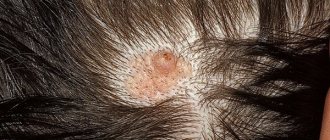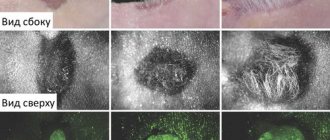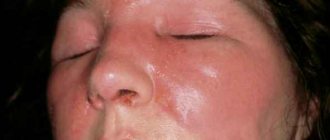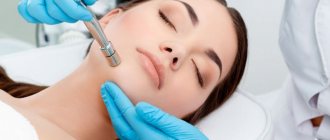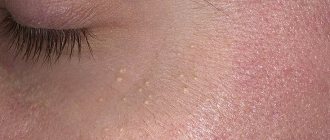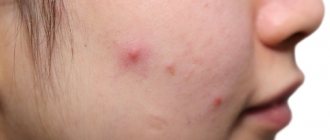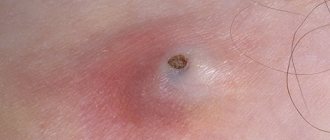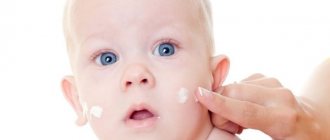Atheroma is a benign skin formation whose capsule contains a fatty inclusion. The symptoms of atheroma are quite scanty - it does not hurt or itch, but is just a small lump on the surface of the body. Signs of atheroma on the scalp are not visualized at all until the lump reaches an impressive size.
The causes of atheroma are blockage of the sebaceous gland duct, as a result of which sebum does not come out, but is encapsulated in the form of a wen. Treatment of the disease is surgical.
Symptoms of atheroma
- rounded, clearly defined contours;
- subcutaneous localization;
- moves easily upon palpation;
- elastic or hard consistency;
- the skin above it does not fold and has a normal color;
- painless when palpated;
- sizes vary from a small pea to a chicken egg;
- the presence of a sebaceous gland duct on the surface.
If the neoplasm exists for a long time, reaches a large size, or is damaged in one way or another, an inflammatory process begins.
When suppuration occurs, the fatty cyst quickly increases in size, becomes painful, and the skin turns red and swells. Spontaneous opening with the release of pus and fatty contents is typical. Manifestations of general intoxication are possible - fever, lack of appetite, weakness.
Atheromas that occur against the background of skin diseases are diagnosed according to the following criteria:
- dense consistency;
- soreness to touch;
- reddish-bluish color;
- sizes from a small pea to a plum;
- often spontaneously opens with the release of serous-purulent contents.
Atheromas can be located on the face (cheeks, wings of the nose, behind the ears), less often - on the skin of the neck and chest. Sometimes a dense capsule forms around it, in which case the pain goes away and the cyst becomes hard.
Treatment of dry seborrhea
To treat dry seborrhea, use sulfur ointment (10%), which is rubbed into the affected areas for a week. Zinc preparations help, especially in advanced cases. When no effect is observed, hormonal medications are used. Vitamins D, E, A, B are used in the complex. Physiotherapy is prescribed.
The diet for seborrhea limits fats (especially of animal origin) and fast carbohydrates (white flour products and sweets). The basis of the diet should be vegetables and fruits, herbs, dairy products, eggs, chicken breast.
Traditional methods of treating dry seborrhea aim to replenish the lack of sebum through oil rubs with herbal infusions. Gently massage the affected areas for 15 minutes. Burdock oil, a mixture of sunflower oil with lemon juice, and sea buckthorn extract in olive oil are very popular. The hair is washed using a decoction of burdock roots, steamed birch buds, and nettle infusion.
Etiology
The causes of atheroma are not fully understood. It is believed that the cyst forms in people with a hereditary predisposition, especially during periods of hormonal changes. The immediate cause is blockage of the sebaceous glands with thickened fatty secretions, dust particles, and skin flakes. Against the background of a closed duct, the gland continues to produce sebum, secretion accumulates, and a new growth gradually forms.
The causes of blockage of the sebaceous glands on the face can be various skin diseases. These include acne, furunculosis, seborrhea. If left untreated, they become responsible for the appearance of cysts. This type of atheroma is called secondary.
The provoking factors that lead to clogging of the fat glands are the following circumstances:
- dirty skin;
- constant microtrauma of certain areas of the body;
- chronic dermatological diseases;
- increased sweating;
- hormonal imbalance;
- disorders of fat and carbohydrate metabolism;
- incorrect use of cosmetics;
- cystic fibrosis;
- older age, more often female.
Sometimes atheroma is called epidermoid, or epidermal, cyst, considering these to be synonyms. But that's not true. Congenital epidermoid cysts of the skin are usually multiple in nature and are most often found on the head, torso, arms, and groin. An epidermoid cyst, like the formation of a sebaceous gland, has a capsule consisting of epithelial cells, but its contents are not sebaceous secretions, but scales of the stratum corneum.
This malformation is often combined with other structural anomalies. Typically, an epidermal cyst forms in childhood or young adulthood. These formations are characterized by a tendency to grow rapidly.
In case of microtrauma or infection through the blood, abscesses may form and the infection may spread to surrounding tissues. Localization in the eyelid area is dangerous, as the inflammatory process quickly spreads to the eyeball.
Acne
The term “acne” comes from the ancient Greek language and means “blossoming”. This is the name for inflammation of the sebaceous gland and hair follicle, at the mouth of which its duct emerges. An eel forms. There are several types of acne: white, red and black. This or that form of seborrhea leads to this. At the same time, oily seborrhea is much more susceptible to acne. On dry skin there are few such manifestations; they are better tolerated by patients. This is due to the fact that it is easier for infections to spread in a fatty environment.
Acne treatment begins with determining the prerequisites for its occurrence: collecting tests that show a detailed picture. This is a general blood test, bacteriology (the doctor takes swabs from the skin), glucose levels, hormones. During this study, it is necessary to take another test - for demodicosis (skin damage by mites). After the examination, individual treatment is prescribed.
Which doctor treats atheroma?
Most often, patients turn to doctors for large cysts of the sebaceous glands, as well as if the general condition is disturbed against the background of suppuration of the formation.
Which doctor should I contact for atheroma? In case of inflammatory phenomena, you should immediately see a surgeon. If there is no inflammation, you can first consult a dermatologist. After a careful examination, he will recommend dynamic monitoring with regular examinations or urgent surgical intervention. To exclude the degeneration of an epidermal cyst, consultation with an oncologist is necessary.
How to treat blocked sebaceous glands
Treatment of atheroma involves radical methods of cyst removal.
The formation can be removed using the classical surgical method. Having made an incision in the skin, the doctor removes it without opening it, along with the capsule. The disadvantages are the need to shave the hair before surgery, and after it - stitches and regular dressings. When suppuration occurs, the surgeon opens the cyst and installs drainage to ensure the drainage of pus. When acute inflammation subsides, the capsule is routinely removed.
In addition, the following methods are used to treat sebaceous gland blockage:
- Electrocoagulation is the burning of a sebaceous cyst with high frequency electric current.
- Plasma coagulation - an argon plasma beam eliminates the problem without bleeding and subsequent scarring of the tissue.
- Radio wave. When exposed to this method, skin damage does not require sutures, does not leave marks in the form of a scar or scar, and the scalp is preserved.
How to treat atheroma in the early stages? Small formations are eliminated using laser beams. The cyst cavity is opened and its contents are thermally destroyed.
When removing a tumor, all methods use local anesthetics.
Treatment of oily seborrhea
To successfully combat the condition of hyperfunction of the sebaceous glands, you should maintain hygiene and not use other people’s washcloths, combs and other care items. Clean skin will prevent infections and the development of complications. Excess fat is removed by degreasing with a 2% solution of salicylic alcohol. The procedure is carried out twice a day. In between, cleanse the skin using high quality soap and warm water.
Despite the fact that hot water quickly washes away fat, it should be avoided: high temperature provokes increased activity of the glands. Finish washing with cold water to close the pores. The head is washed with a suitable shampoo that guarantees the destruction of pathogenic flora. Since a fungal infection may occur, appropriate remedies are used.
No creams, ointments, lotions, tonics or powders are allowed. They disrupt the acid-base balance of the skin, close pores, and slow down healing. Regular sunbathing and, in bad weather, quartz treatment will help restore a healthy complexion. Ultraviolet rays kill infection and leave a beautiful tan. Sea baths and walking quickly normalize metabolism, which helps in treating the sebaceous glands.
How to treat atheroma at home
To get rid of atheroma - neoplasms on the skin of various origins, traditional healers offer a lot of remedies. Under the influence of various drugs - honey, lamb fat, pieces of silver, leaves of Kalanchoe or coltsfoot - the growth of education may temporarily slow down.
To treat inflamed sebaceous glands on the face, healers suggest using freshly squeezed aloe juice, which is applied to the skin several times during the day. Can blockage of the sebaceous glands resolve on its own after such therapy? This remedy sometimes gives a temporary positive effect, but you should not hope that the cyst will resolve.
Any methods of traditional medicine can be used only with the permission of the attending physician.
Diagnostics
Identifying atheroma on the face is not difficult. The primary diagnosis can be made by a cosmetologist or dermatologist after examining the patient. However, such a cyst should be differentiated from other, more dangerous skin lesions. This:
- lipoma is a benign tumor of adipose tissue, unlike atheroma, which is covered with a capsule; it “fuses” with the subcutaneous tissue;
- granuloma - a pathology of connective tissue cells, externally looks like small nodules;
- fibroma is a benign connective tissue tumor. Like atheroma, it is painless and does not cause inconvenience to the patient;
- lymphadenitis – inflammation accompanied by an increase in the size of the lymph nodes;
- syphilitic gumma is a manifestation of tertiary syphilis, externally similar to atheroma.
In order to exclude the listed pathologies, the doctor needs to collect anamnesis and find out possible risk factors. The final diagnosis is made during surgery and by histological examination of the cyst tissue. Clinical blood and urine tests are also taken from the person. A scraping is necessary to identify the cause of skin problems.
Prevention of blockage of the sebaceous glands
Since the causes of atheroma are not fully established, preventive measures are defined in the most general context. You can prevent blockage of the skin's sebaceous glands by following simple hygiene rules:
- maintaining body cleanliness;
- use of personal protective equipment when working in hazardous industries;
- fight against excess oily skin.
If there is a hereditary predisposition, a person needs to undergo regular medical examinations from specialists.
Blockage of the sebaceous glands is not only a cosmetic defect, but often a signal of serious health problems. If a fatty cyst appears, you should contact a dermatologist or surgeon for examination and determine further treatment tactics. Emergency medical care is especially important for purulent inflammation of this skin defect. Attempts to independently solve the problem are fraught with complications and relapses.
There are no similar articles.
The benefits of physiotherapeutic procedures for meibomian blepharitis
For blepharitis, treatment using devices is highly effective. The duration of the course is determined by the doctor, taking into account the characteristics of the disease. What procedures are effective in treating blepharitis:
- UHF - anti-inflammatory effect, relieving swelling, softening hardened secretions;
- magnetotherapy - increased blood flow, improved metabolic processes;
- electrophoresis - this treatment is performed using a drug that is injected with direct current into the upper layer of the epidermis;
- ultraviolet radiation has a tonic, bactericidal, anti-inflammatory effect.
For the effectiveness of hardware therapy to be high, regularity is necessary. Try not to miss treatment sessions and complete the entire course prescribed by the specialist.
